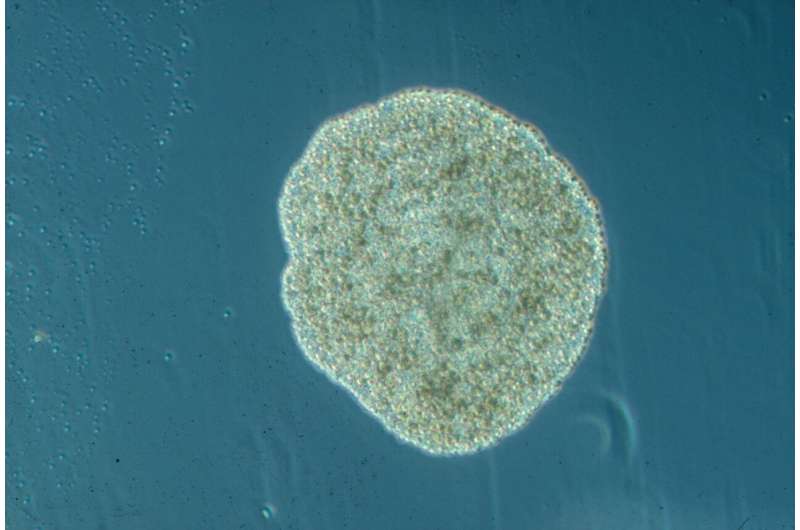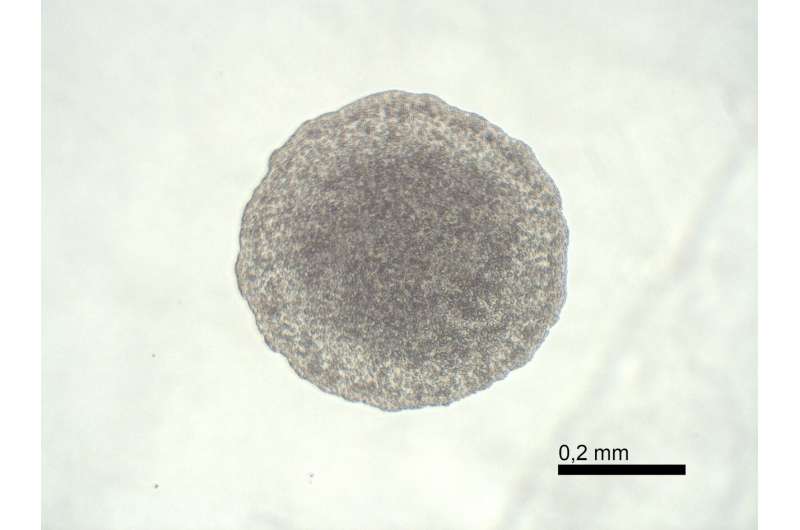World's simplest animals get their place in the tree of life

The group with the world's simplest animals—tiny blob-like life forms with no organs and just a few cell types—finally has a fleshed-out family tree built by a research group led by the American Museum of Natural History, St. Francis College, and the University of Veterinary Medicine Hannover.
The study comes more than 100 years after the discovery of these ameboid animals called placozoans and represents the first—and potentially only—time in the 21st century that a backbone Linnaean taxonomy is constructed for an entire animal phylum. Published today in the journal Frontiers in Ecology and Evolution, the research is based on genetic makeup—the presence and absence of genes—rather than outward physical appearance, which is traditionally used to classify organisms.
"Placozoans look like miniscule, shape-shifting disks—basically, they are the pancake of the animal world," said the study's co-lead author Michael Tessler, a research associate at the Museum and an assistant professor at St. Francis College. "For a taxonomist looking through a microscope, even a powerful one, there are almost no characters to compare and differentiate them. Yet, despite most of them looking almost exactly the same, we know that on the genetic level, there are very distinct lineages."
The first placozoan species was described in 1883, and Placozoa remained a "phylum of one" until DNA-based research in the last 20 years revealed that it contains multiple lineages. Most placozoans, which generally live in tropical and subtropical waters across the globe, are about the size of a grain of sand, with hair-like structures that allow them to move. "After decades of turmoil, this most exciting phylum has finally gotten the attention it deserves," said senior author Bernd Schierwater, a professor at the University of Veterinary Medicine Hannover.

"We wanted to know the relationships within this ancient group of animals and where it sits in the tree of life," said co-lead author Johannes Neumann, a recent doctoral graduate from the Museum's Richard Gilder Graduate School. "People have been speculating about that for decades, but now, by looking at differences among placozoans on the molecular level, we're able to paint a clear picture of how these animals are related to one another."
The researchers used a method called molecular morphology—using differences in DNA sequences and other molecular characters—to make classifications. In doing so, they established a backbone taxonomy: two new classes, four orders, three families, one genus, and one species. Their research also suggests that placozoans are most closely related to cnidarians (a group of aquatic animals including jellyfish, corals, and sea anemones) and bilaterians (animals that have a left and right side, like insects and humans).
"I personally collected placozoans on six continents for almost 10 years, did lab work and bioinformatic work on them, but it took decades of effort from a great number of colleagues to finally get to this exciting first classification for this cryptic phylum," Neumann said. "This is why we call our newly described species Cladtertia collaboinventa, which means 'discovered in collaboration.'"
The authors suggest that this study could serve as a template to revisit systematics of other organisms that look very similar, such as bacteria, fungi, protists, and parasites. Tessler also is the lead author of a second paper out now in Frontiers in Ecology and Evolution that makes the case for molecular morphology in other groups of organisms that have few distinguishable visual features but are genetically diverse.
"Taxonomic blank slates are problematic. Without names, communication is hampered, and other scientific progress is slowed," said Tessler. "We suggest that the morphology of molecules, such as proteins—which have distinctive structures—should not be considered as anything less than traditional morphology."
More information: Michael Tessler et al, Phylogenomics and the first higher taxonomy of Placozoa, an ancient and enigmatic animal phylum, Frontiers in Ecology and Evolution (2022). DOI: 10.3389/fevo.2022.1016357
Michael Tessler et al, Let's end taxonomic blank slates with molecular morphology, Frontiers in Ecology and Evolution (2022). DOI: 10.3389/fevo.2022.1016412
Journal information: Frontiers in Ecology and Evolution
Provided by American Museum of Natural History





















